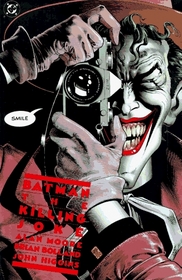First published 25 years ago, "The Killing Joke" may be one of the three finest Batman stories ever told. It's certainly the finest ever written about the Joker.
Killingjoke[1]Written by Alan Moore and illustrated by Brian Bolland, "The Killing Joker" has the Batman starting to boil over in his frustration with his green-haired foe. He knows how Harvey Dent became Two-Face, and that all his decisions come down to the flip of a coin. He knows that the Edward Nigma is the Riddler, and he understands the Riddler's compulsion to lead people on a chase. Ra's al Ghul, the Royal Flush Gang, Poison Ivy, the Penguin -- Batman gets the entire Gotham City rogues gallery, and knows how they work and why. But the Joker remains a mystery to him, and Batman wants to change that before it becomes too late and one of them kills the other.
The Joker, of course, has other plans.
In one of the most iconic scenes from the comic, the Joker shoots Barbara Gordon at point-blank range and paralyzes her. This event, which sidelined Barbara Gordon from being Batgirl for the next 25 years of comics, wasn't even the main attraction as far as the Joker was concerned. His goal is simply to drive her father, the police commissioner, insane.
"The Killing Joke" is the comic that cemented the Joker in readers' minds as a nihilistic madman, and one of the central themes of the comic is how far one bad day can take a person past the edge. Without knowing the details, the Joker alludes to the events that drove Bruce Wayne to become Batman, and assumes that Commissioner Gordon also has been pushed over the edge by what the Joker has done.
But what makes the story worth reading is that Moore depicts the bad day that pushed the Joker himself over the edge, when all his hopes and dreams came crashing down, when the bottom fell out of his world, and he plunged into the void.
Around the same time that DC Comics published "The Killing Joke," it also published Frank Miller's "The Dark Knight Returns" and "Batman: Year One," which showcased the endpoint and genesis of Bruce Wayne's career as the Caped Crusader, and that established him as an antihero with mental health issues of his own. Add "The Killing Joke" to the mix, and there's nothing else DC has published that comes even close to their level.
Killingjoke[1]Written by Alan Moore and illustrated by Brian Bolland, "The Killing Joker" has the Batman starting to boil over in his frustration with his green-haired foe. He knows how Harvey Dent became Two-Face, and that all his decisions come down to the flip of a coin. He knows that the Edward Nigma is the Riddler, and he understands the Riddler's compulsion to lead people on a chase. Ra's al Ghul, the Royal Flush Gang, Poison Ivy, the Penguin -- Batman gets the entire Gotham City rogues gallery, and knows how they work and why. But the Joker remains a mystery to him, and Batman wants to change that before it becomes too late and one of them kills the other.
The Joker, of course, has other plans.
In one of the most iconic scenes from the comic, the Joker shoots Barbara Gordon at point-blank range and paralyzes her. This event, which sidelined Barbara Gordon from being Batgirl for the next 25 years of comics, wasn't even the main attraction as far as the Joker was concerned. His goal is simply to drive her father, the police commissioner, insane.
"The Killing Joke" is the comic that cemented the Joker in readers' minds as a nihilistic madman, and one of the central themes of the comic is how far one bad day can take a person past the edge. Without knowing the details, the Joker alludes to the events that drove Bruce Wayne to become Batman, and assumes that Commissioner Gordon also has been pushed over the edge by what the Joker has done.
But what makes the story worth reading is that Moore depicts the bad day that pushed the Joker himself over the edge, when all his hopes and dreams came crashing down, when the bottom fell out of his world, and he plunged into the void.
Around the same time that DC Comics published "The Killing Joke," it also published Frank Miller's "The Dark Knight Returns" and "Batman: Year One," which showcased the endpoint and genesis of Bruce Wayne's career as the Caped Crusader, and that established him as an antihero with mental health issues of his own. Add "The Killing Joke" to the mix, and there's nothing else DC has published that comes even close to their level.




